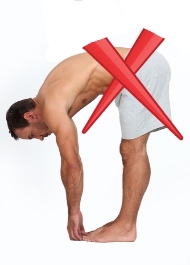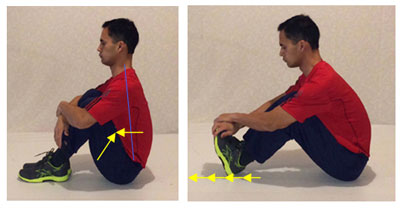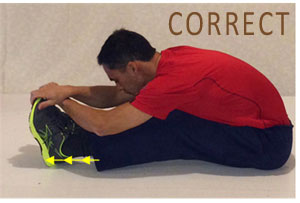Learn the Correct Hamstring Stretch to Prevent Back Pain
By Sherwin Nicholson | Updated May 1, 2020

Avoid These Painful Mistakes
Why is it so important to stretch them in the first place and is there really a right or wrong way?
It’s important and there is a better way.
Tight hamstrings are directly linked to lower back pain. They reduce your pelvic mobility and prevent the pelvis from tilting together with the lumbar spine as you bend or lean forward.
Most of do have tight hamstrings and it’s no coincidence that most of us also have both weak and shortened hams.
Your hip movements are key!
This matters because you need to use your pelvis/hips and legs more often to avoid hurting your back. It’s hard to ignore this fact and any discomfort that you have now is a sure sign of it.
Unfortunately, the more popularly ways we stretch our leg muscles to deal with this problem actually worsen it. We usually end causing more injury to ourselves long before we can have any muscle lengthening or pain relief.
Leaning Forward is Very Bad for Your Back
You’re not really doing anything to your hamstrings at all. You’re just creating tension and fatigue. At the same time, you’re generating a dangerously high amount of pressure on your L1-L5-S1 discs.
Sadly, there is a good chance that these discs will wear long before your ‘hams’ see any benefit at all.
The current way to stretch that is popular requires you to begin in the upright position and to bend forward then to touch your toes with little attention to control.

Another favorite variation of this is when you are in the seated position with one leg extended. Here, you also lean forward while touching your toes.
I bet money that if you were to ask anyone to touch their own toes, that you would see a pretty scary bend in their lower back. NOT GOOD. That a disc injury waiting to happen!
This method has VERY LITTLE gain for the strain involved
The first method uses gravity to aid the stretch. The latter uses your arms to achieve the same effect. Both place unnecessary force on your discs and lower back muscles and actually have minimal impact on muscle length as lower back fatigue predominates the duration of time the movement is done.
Ultimately, it will hurt, and you’ll end up avoiding the need to lengthen your muscles at all. Doing this creates a vicious cycle where lower back pain is worsened by tight hamstrings, and the stretch ineffectively compounds the problem.
Flaws in the standard stretch
This common stretch encourages you to begin with your hamstrings already in a somewhat lengthened position and uses the action of the pelvis to further lengthen them. Provided that your spine is stable and there are no disc issues, this movement is still not considered safe.
Tight hamstrings can demand a lot of effort to lengthen them
They require a significant amount of time and sustained tension to lengthen. It is from the leverage of the spine acting on the pelvis that is necessary for this lengthening to occur. But by its very design, this technique will require an unbalanced and dangerous force on the lumbar disc.
The average person that may not have pain is very prone to it by using this technique routinely. Because it requires that you put intense pressure on every lumbar disc, there is a good chance that you may rupture your them.
You need to stabilize your back before you stretch
While your hamstrings are one of the most resistant groups for lengthening, the lower back is consequently the least resistant.
To prevent injury, it is necessary for you to provide a stable position for your spine while having the most effective movement to stretch your leg muscles. An effective method should also provide stability for your pelvis to prevent any discomfort. The following method can help you do this.
Seated Hamstring Stretch
Go to TIGHT HAMSTRINGS for the full Details and Steps
By following this technique, you allow the following protective actions in a specific order.
- Lumbar Stability
- Pelvic Stability
- Upper Back and Neck Stability
- Femoral Flexibility
- Muscle Isolation & Lengthening
By following this method, you can minimize and prevent disc injury while reducing tightness, which in turn will save your back.
Would you like more help with your hams?
How to manage tight hamstrings


